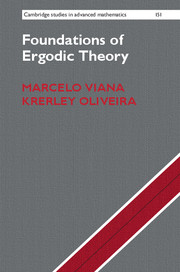Book contents
- Frontmatter
- Contents
- Preface
- 1 Recurrence
- 2 Existence of invariant measures
- 3 Ergodic theorems
- 4 Ergodicity
- 5 Ergodic decomposition
- 6 Unique ergodicity
- 7 Correlations
- 8 Equivalent systems
- 9 Entropy
- 10 Variational principle
- 11 Expanding maps
- 12 Thermodynamic formalism
- Appendix A Topics in measure theory, topology and analysis
- Hints or solutions for selected exercises
- References
- Index of notation
- Index
8 - Equivalent systems
Published online by Cambridge University Press: 05 February 2016
- Frontmatter
- Contents
- Preface
- 1 Recurrence
- 2 Existence of invariant measures
- 3 Ergodic theorems
- 4 Ergodicity
- 5 Ergodic decomposition
- 6 Unique ergodicity
- 7 Correlations
- 8 Equivalent systems
- 9 Entropy
- 10 Variational principle
- 11 Expanding maps
- 12 Thermodynamic formalism
- Appendix A Topics in measure theory, topology and analysis
- Hints or solutions for selected exercises
- References
- Index of notation
- Index
Summary
This chapter is devoted to the isomorphism problem in ergodic theory: under what conditions should two systems (f, μ) and (g,ν) be considered “the same” and how does one decide, for given systems, whether they are in those conditions?
The fundamental notion is called ergodic equivalence: two systems are said to be ergodically equivalent if, restricted to subsets with full measure, the corresponding transformations are conjugated by some invertible map that preserves the invariant measures. Through such a map, properties of either system may be translated to corresponding properties of the other system.
Although this is a natural notion of isomorphism in the context of ergodic theory, it is not an easy one to handle. In general, the only way to prove that two given systems are equivalent is by exhibiting the equivalence map more or less explicitly. On the other hand, the most usual way to show that two systems are not equivalent is by finding some property that holds for one but not the other.
Thus, it is useful to consider a weaker notion, called spectral equivalence: two systems are spectrally equivalent if their Koopman operators are conjugated by some unitary operator. Two ergodically equivalent systems are always spectrally equivalent, but the converse is not true.
The idea of spectral equivalence leads to a rich family of invariants, related to the spectrum of the Koopman operator, that must have the same value for any two systems that are equivalent and, thus, may be used to exclude that possibility. Other invariants, of non-spectral nature, have an equally crucial role. The most important of all, the entropy, will be treated in Chapter 9.
The notions of ergodic equivalence and spectral equivalence, and the relations between them, are studied in Sections 8.1 and 8.2, respectively. In Sections 8.3 and 8.4 we study two classes of systems with opposite dynamical features: transformations with discrete spectrum, that include the ergodic translations on compact abelian groups, and transformations with a Lebesgue spectrum, which have the Bernoulli shifts as the main example.
These two classes of systems, as well as others that we introduced previously (ergodicity, strong mixing, weak mixing) are invariants of spectral equivalence and, hence, also of ergodic equivalence. Finally, in Section 8.5 we discuss a third notion of equivalence, that we call ergodic isomorphism, especially in the context of Lebesgue spaces.
- Type
- Chapter
- Information
- Foundations of Ergodic Theory , pp. 213 - 241Publisher: Cambridge University PressPrint publication year: 2016

